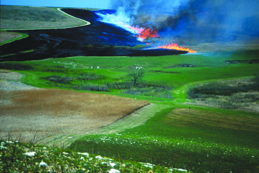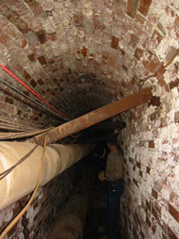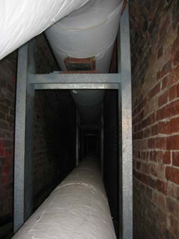FEDERAL MONEY 'STIMULATING' WORK AT K-STATE
From atomic collisions to steam pipes, millions of dollars disbursed under the American Recovery and Reinvestment Act of 2009 are being well spent at K-State.
 To date, the university has received more than $2.1 million for scientific research and is anticipating several million more for a major lab upgrade and long-deferred infrastructure projects. A $2.3 million award for infrastructure projects will kick off a steam pipe replacement project on the southwest part of campus in the spring, with another $5.6 million expected in 2010 to fund additional infrastructure projects that have been deferred.
To date, the university has received more than $2.1 million for scientific research and is anticipating several million more for a major lab upgrade and long-deferred infrastructure projects. A $2.3 million award for infrastructure projects will kick off a steam pipe replacement project on the southwest part of campus in the spring, with another $5.6 million expected in 2010 to fund additional infrastructure projects that have been deferred.
The American Recovery and Reinvestment Act of 2009, also known as the stimulus bill, included about $21.5 billion for federal research and development across the nation. The program includes large increases in federal support for research, education, job development, infrastructure and many other areas vital to K-State.
In the arena of research, K-State scientists are spending the dollars on projects with real-world implications. From potentially resolving eye problems suffered by diabetics to the ins and outs of ultracold quantum gases, K-State's experts are leading the way.
"K-State faculty members are exceedingly successful in any research competition and this has been no exception," said Ron Trewyn, K-State's vice president for research. "Even with very short submission timelines during the busiest period of the academic year, they stepped up to the challenge. K-State faculty are proven winners, so it's no surprise they're leading the way again."
Researchers being supported by stimulus dollars include:
* K-State biologist Katsura Asano is collaborating with Harvard researchers to create a clearer picture of certain cellular process that play a role in chronic diseases like cancer. Asano's grant of $200,000 from the National Institutes of Health's National Institute of General Medical Sciences will help him study how eukaryotic cells -- like the ones humans have -- initiate the process of building proteins. The long-term goal of Asano's research is to understand the complex pathway that sets cells into motion to build proteins accurately rather than with an alteration that can result in malignancy or chronic disease.
* K-State ecologists Ari Jumpponen, Brett Sandercock and Bruce Snyder are using their $210,000 from the National Science Foundation to enable undergraduate researchers to study ecology and evolution on the Konza Prairie. The Research Experience for Undergraduates Site program in biology started in 1995 and brings outstanding students to K-State for a 10-week summer research program where they take on independent research projects. The focus of the K-State site is to study the biota of the tallgrass prairie with implications for predicting and mitigating the consequences of global change.
 * K-State biochemist Dolores Takemoto is using $366,000 in federal stimulus funding to do work that could help diabetics preserve their eyesight. Her research looks at how a particular enzyme -- protein kinase C gamma, or PKC gamma -- affects the eye's lens, and more specifically how it is controlled in normal cells versus the loss of control in diabetics. PKC gamma helps control gap junctions -- the connections created between certain types of cells -- and diabetics and those with galactosemia have less PKC gamma in their lenses. When PKC gamma is decreased, control of these intercellular connections is lost, resulting in damage to the lens cells. Takemoto is looking for ways to control PKC gamma in normal lenses and wants to understand how diabetes and galactosemia decrease PKC gamma and how this affects gap junctions. Greater understanding could help scientists develop better drugs to prevent diabetics from losing PKC gamma.
* K-State biochemist Dolores Takemoto is using $366,000 in federal stimulus funding to do work that could help diabetics preserve their eyesight. Her research looks at how a particular enzyme -- protein kinase C gamma, or PKC gamma -- affects the eye's lens, and more specifically how it is controlled in normal cells versus the loss of control in diabetics. PKC gamma helps control gap junctions -- the connections created between certain types of cells -- and diabetics and those with galactosemia have less PKC gamma in their lenses. When PKC gamma is decreased, control of these intercellular connections is lost, resulting in damage to the lens cells. Takemoto is looking for ways to control PKC gamma in normal lenses and wants to understand how diabetes and galactosemia decrease PKC gamma and how this affects gap junctions. Greater understanding could help scientists develop better drugs to prevent diabetics from losing PKC gamma.
* K-State physicist Brett Esry is studying what happens when atoms collide in groups of three and four. These few-body collisions play an important role in experiments on ultracold quantum gases. Esry said a better theoretical understanding of these collisions could help physicists improve design of experiments and interpretation of what has been measured. A better understanding of ultracold quantum gases could also affect such technologically important phenomena as superconductivity and quantum computing. Moreover, understanding few-body collisions can improve our understanding of chemistry in outer space. To support his research, Esry received a $282,000 award from the National Science Foundation under the American Recovery and Reinvestment Act.
In addition, K-State's Macdonald Laboratory -- where Esry conducts his research -- is also receiving $1.3 million from the Department of Energy to improve the lab's infrastructure and add a new laser system with nearly 10 times the current capability.
* K-State chemist Ryszard Jankowiak received a $380,000 stimulus grant from the National Science Foundation to study an area of physical chemistry that will provide more insight into the electronic structure and energy transfer processes in natural and artificial 
 photosynthetic complexes. Some day, this could help in the development of devices that more efficiently convert solar energy into electricity. Jankowiak and his research team will look at two photosynthetic complexes from a type of bacteria and use complementary methods and new approaches to advance the understanding of photosynthesis. He will also develop a program to encourage high school students to pursue careers in science.
photosynthetic complexes. Some day, this could help in the development of devices that more efficiently convert solar energy into electricity. Jankowiak and his research team will look at two photosynthetic complexes from a type of bacteria and use complementary methods and new approaches to advance the understanding of photosynthesis. He will also develop a program to encourage high school students to pursue careers in science.
K-State is also expecting $2.3 million through the American Recovery and Reinvestment Act to put long-deferred infrastructure projects to rest.
The first project to be bid will be the replacement of the 80-year-old steam pipes serving the southwest corner of campus. Work on the leaky pipes, which provide hot water and steam for heat in the winter, could begin as soon as the spring.
This project is one from a long list of maintenance work deferred over the years because of inadequate state funding of Kansas Board of Regents' institutions.
K-State is scheduled to receive an additional $5.6 million in stimulus funds to work on critical infrastructure projects in 2010.
From top to bottom:
Dolores Takemoto received stimulus funding to conduct research that could help prevent diabetics from losing their eyesight; Another stimulus project provides a 10-week summer experience where undergraduate researchers study ecology and evolution on the Konza Prairie; A before and after shot of steam tunnel replacement work like that to be funded by stimulus money.